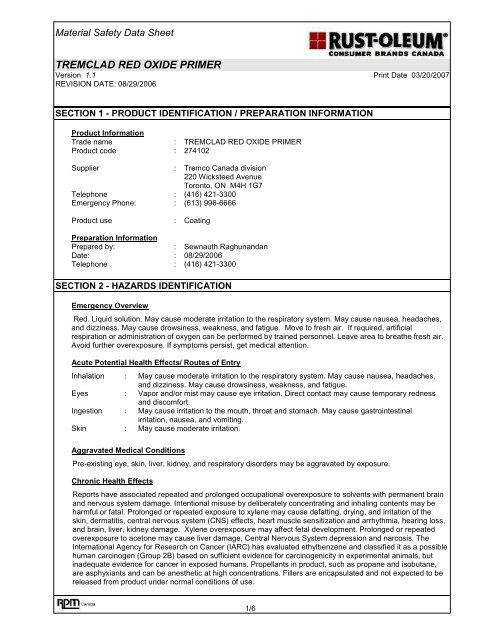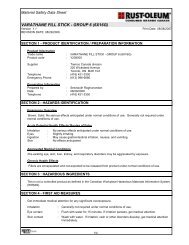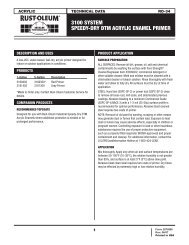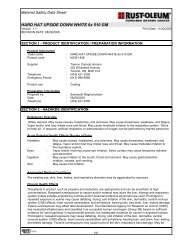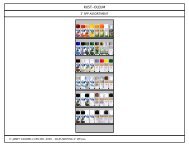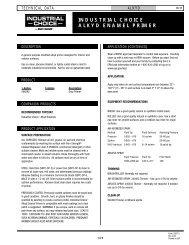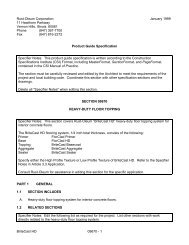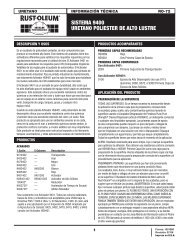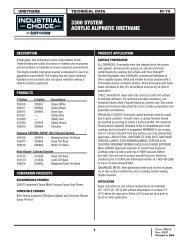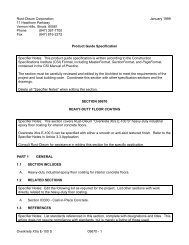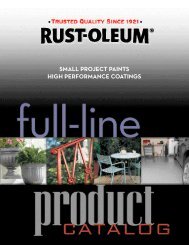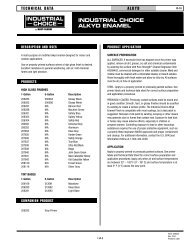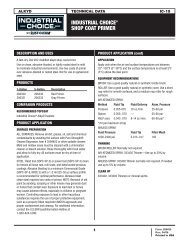TREMCLAD RED OXIDE PRIMER - RustOleum.com
TREMCLAD RED OXIDE PRIMER - RustOleum.com
TREMCLAD RED OXIDE PRIMER - RustOleum.com
Create successful ePaper yourself
Turn your PDF publications into a flip-book with our unique Google optimized e-Paper software.
Material Safety Data Sheet<br />
<strong>TREMCLAD</strong> <strong>RED</strong> <strong>OXIDE</strong> <strong>PRIMER</strong><br />
Version 1.1 Print Date 03/20/2007<br />
REVISION DATE: 08/29/2006<br />
SECTION 1 - PRODUCT IDENTIFICATION / PREPARATION INFORMATION<br />
Product Information<br />
Trade name : <strong>TREMCLAD</strong> <strong>RED</strong> <strong>OXIDE</strong> <strong>PRIMER</strong><br />
Product code : 274102<br />
Supplier : Tremco Canada division<br />
220 Wicksteed Avenue<br />
Toronto, ON M4H 1G7<br />
Telephone : (416) 421-3300<br />
Emergency Phone: : (613) 996-6666<br />
Product use : Coating<br />
Preparation Information<br />
Prepared by: : Sewnauth Raghunandan<br />
Date: : 08/29/2006<br />
Telephone : (416) 421-3300<br />
SECTION 2 - HAZARDS IDENTIFICATION<br />
Emergency Overview<br />
Red. Liquid solution. May cause moderate irritation to the respiratory system. May cause nausea, headaches,<br />
and dizziness. May cause drowsiness, weakness, and fatigue. Move to fresh air. If required, artificial<br />
respiration or administration of oxygen can be performed by trained personnel. Leave area to breathe fresh air.<br />
Avoid further overexposure. If symptoms persist, get medical attention.<br />
Acute Potential Health Effects/ Routes of Entry<br />
Inhalation : May cause moderate irritation to the respiratory system. May cause nausea, headaches,<br />
and dizziness. May cause drowsiness, weakness, and fatigue.<br />
Eyes : Vapor and/or mist may cause eye irritation. Direct contact may cause temporary redness<br />
and dis<strong>com</strong>fort.<br />
Ingestion : May cause irritation to the mouth, throat and stomach. May cause gastrointestinal<br />
irritation, nausea, and vomiting.<br />
Skin : May cause moderate irritation.<br />
Aggravated Medical Conditions<br />
Pre-existing eye, skin, liver, kidney, and respiratory disorders may be aggravated by exposure.<br />
Chronic Health Effects<br />
Reports have associated repeated and prolonged occupational overexposure to solvents with permanent brain<br />
and nervous system damage. Intentional misuse by deliberately concentrating and inhaling contents may be<br />
harmful or fatal. Prolonged or repeated exposure to xylene may cause defatting, drying, and irritation of the<br />
skin, dermatitis, central nervous system (CNS) effects, heart muscle sensitization and arrhythmia, hearing loss,<br />
and brain, liver, kidney damage. Xylene overexposure may affect fetal development. Prolonged or repeated<br />
overexposure to acetone may cause liver damage, Central Nervous System depression and narcosis. The<br />
International Agency for Research on Cancer (IARC) has evaluated ethylbenzene and classified it as a possible<br />
human carcinogen (Group 2B) based on sufficient evidence for carcinogenicity in experimental animals, but<br />
inadequate evidence for cancer in exposed humans. Propellants in product, such as propane and isobutane,<br />
are asphyxiants and can be anesthetic at high concentrations. Fillers are encapsulated and not expected to be<br />
released from product under normal conditions of use.<br />
1/6
Material Safety Data Sheet<br />
<strong>TREMCLAD</strong> <strong>RED</strong> <strong>OXIDE</strong> <strong>PRIMER</strong><br />
Version 1.1 Print Date 03/20/2007<br />
REVISION DATE: 08/29/2006<br />
Target Organs: Skin.<br />
SECTION 3 : HAZARDOUS ING<strong>RED</strong>IENTS<br />
Chemical Name CAS-No. Weight % Range<br />
Acetone 67-64-1 15.0 - 40.0<br />
Liquefied petroleum gases 68476-86-8 15.0 - 40.0<br />
Isobutane 75-28-5 7.0 - 13.0<br />
Xylene 1330-20-7 3.0 - 7.0<br />
Ethylbenzene 100-41-4 0.5 - 1.5<br />
The ingredients listed above are hazardous as defined in the controlled products regulation. (CPR).<br />
SECTION 4 - FIRST AID MEASURES<br />
Get immediate medical attention for any significant overexposure.<br />
Inhalation : Move to fresh air. If required, artificial respiration or administration of oxygen can be<br />
performed by trained personnel.Leave area to breathe fresh air. Avoid further<br />
overexposure. If symptoms persist, get medical attention.<br />
Eye contact : Flush with water for at least 15 minutes while holding eye lids apart. Get medical<br />
attention immediately.<br />
Skin contact : Clean area of contact thoroughly using soap and water. If irritation, rash or other<br />
disorders develop, get medical attention immediately.<br />
Ingestion : Do not induce vomiting unless advised by a physician. Call nearest Poison Control<br />
Center or Physician immediately.<br />
SECTION 5: FIRE / EXPLOSION HAZARDS<br />
Flash point : 40 °C, 104 °F<br />
Method : Setaflash Closed Cup<br />
Lower explosion limit : 1.00 %(V) Solvent<br />
Upper explosion limit : 5 %(V) Solvent<br />
Autoignition temperature : Not available.<br />
Extinguishing media : If water fog is ineffective, use carbon dioxide, dry chemical or foam.<br />
Hazardous <strong>com</strong>bustion<br />
products<br />
Protective equipment for<br />
firefighters<br />
: Smoke, fumes.Carbon monoxide and carbon dioxide can form.Nitrogen<br />
oxides can form.<br />
: Use accepted fire fighting techniques. Wear full firefighting protective<br />
clothing, including self-contained breathing apparatus (SCBA).Water<br />
may be used to cool containers to minimize pressure build-up.<br />
Fire and explosion conditions : Vapor concentrations in enclosed areas may ignite explosively.Product<br />
may ignite if heated in excess of its flash point.Vapors may travel to<br />
sources of ignition and flashback.Closed container, may burst when<br />
exposed to extreme heat.Empty containers may contain ignitable<br />
vapors.<br />
2/6
Material Safety Data Sheet<br />
<strong>TREMCLAD</strong> <strong>RED</strong> <strong>OXIDE</strong> <strong>PRIMER</strong><br />
Version 1.1 Print Date 03/20/2007<br />
REVISION DATE: 08/29/2006<br />
SECTION 6 - ACCIDENTAL RELEASE MEASURES<br />
Use appropriate protective equipment. Avoid contact with material. Remove sources of ignition immediately.<br />
Stop flow of material if safe to do so. Contain spill and keep out of water courses. Ventilate area.<br />
SECTION 7 - HANDLING AND STORAGE<br />
Prevent inhalation of vapor, ingestion, and contact with skin eyes and clothing. Keep container closed when<br />
not in use. Precautions also apply to emptied containers. To prevent generation of static discharges, use<br />
bonding/grounding connection when pouring liquid. Extinguish all ignition sources including pilot lights, nonexplosion<br />
proof motors and electrical equipment until vapors dissipate. Personal protective equipment must be<br />
worn during maintenance or repair of contaminated mixer, reactor, or other equipment. Keep container closed<br />
when not in use. Vapor may migrate to sources of ignition. Do not smoke, weld, generate sparks, or use flame<br />
near container. Store in sealed containers in a cool, dry, ventilated warehouse location.<br />
SECTION 8 - PREVENTIVE MEASURES/EXPOSURE CONTROLS/PERSONAL PROTECTION<br />
Personal protection equipment<br />
Respiratory protection : Wear appropriate, properly fitted NIOSH/MSHA approved organic vapor or<br />
supplied air respirator when airborne contaminant level(s) are expected to<br />
exceed exposure limits indicated on the MSDS. Follow manufacturer's<br />
directions for respirator use.<br />
Hand protection : Use suitable impervious nitrile or neoprene gloves and protective apparel to<br />
reduce exposure.<br />
Eye protection : Wear appropriate eye protection.Wear chemical safety goggles and/or face<br />
shield to prevent eye contact. Do not wear contact lenses. Do not touch eyes<br />
with contaminated body parts or materials. Have eye washing facilities readily<br />
available.<br />
Protective measures : Use professional judgment in the selection, care, and use.Inspect and replace<br />
equipment at regular intervals.<br />
Engineering measures : Use only in well ventilated areas. Provide maximum ventilation in enclosed<br />
areas.Use local exhaust when the general ventilation is inadequate.<br />
Exposure Limits<br />
Chemical Name CAS Number Regulation Limit Form<br />
Acetone 67-64-1 Ontario TWA: 500 ppm<br />
Ontario STEL: 750 ppm<br />
ACGIH TWA: 500 ppm<br />
ACGIH STEL: 750 ppm<br />
Isobutane 75-28-5 ACGIH TWA: 1,000 ppm<br />
Ontario TWA: 1,900 mg/m3<br />
Xylene 1330-20-7 Ontario TWA: 435 mg/m3<br />
Ontario STEL: 650 mg/m3<br />
ACGIH TWA: 100 ppm<br />
ACGIH STEL: 150 ppm<br />
3/6
Material Safety Data Sheet<br />
<strong>TREMCLAD</strong> <strong>RED</strong> <strong>OXIDE</strong> <strong>PRIMER</strong><br />
Version 1.1 Print Date 03/20/2007<br />
REVISION DATE: 08/29/2006<br />
Chemical Name CAS Number Regulation Limit Form<br />
Ethylbenzene 100-41-4 Ontario TWA: 435 mg/m3<br />
Ontario STEL: 540 mg/m3<br />
ACGIH TWA: 100 ppm<br />
ACGIH STEL: 125 ppm<br />
SECTION 9 - PHYSICAL AND CHEMICAL PROPERTIES<br />
Physical State<br />
: Liquid<br />
Form<br />
: Liquid solution<br />
Color<br />
: Red<br />
Odor<br />
: Naptha<br />
pH<br />
: Not available.<br />
Vapour pressure<br />
: Not available.<br />
Vapor density<br />
: Heavier than air<br />
Melting point/range<br />
: Not available.<br />
Freezing point<br />
: Not available.<br />
Boiling point/range : 400 °C, 752 °F<br />
Water solubility<br />
: Partially soluble<br />
Evaporation Rate:<br />
: Not available.<br />
Specific Gravity : 1.33<br />
% Volatile Weight : 58 %<br />
SECTION 10 - REACTIVITY / STABILITY<br />
Substances to avoid<br />
Stability<br />
Hazardous polymerization<br />
: Oxidizing agents.Strong acids.Strong bases.<br />
: Stable under normal conditions. Avoid welding arcs, flames or other high<br />
temperature sources.<br />
: Will not occur.<br />
SECTION 11 - TOXICOLOGICAL INFORMATION<br />
Xylene, CAS-No.: 1330-20-7<br />
Acute oral toxicity (LD-50 oral) 3,523 - 8,600 mg/kg ( Rat )<br />
Acute inhalation toxicity (LC-50) 6,350 mg/l ( Rat )<br />
Ethylbenzene, CAS-No.: 100-41-4<br />
Acute oral toxicity (LD-50 oral) 3,500 mg/kg ( Rat )<br />
Acute dermal toxicity (LD-50 dermal) 17,800 mg/kg ( Rabbit )<br />
4/6
Material Safety Data Sheet<br />
<strong>TREMCLAD</strong> <strong>RED</strong> <strong>OXIDE</strong> <strong>PRIMER</strong><br />
Version 1.1 Print Date 03/20/2007<br />
REVISION DATE: 08/29/2006<br />
SECTION 12 - ECOLOGICAL INFORMATION<br />
No Data Available<br />
SECTION 13 - WASTE DISPOSAL CONSIDERATIONS<br />
Disposal Method : Dispose according to all applicable regulations (hazardous household waste depot, or<br />
as liquid industrial waste for industrial product).<br />
SECTION 14 - TRANSPORTATION / SHIPPING DATA<br />
TDG / DOT Shipping Description:<br />
NOT REGULATED<br />
SECTION 15 - REGULATORY INFORMATION<br />
North American Inventories:<br />
All <strong>com</strong>ponents are listed or exempt from the TSCA inventory.<br />
This product or its <strong>com</strong>ponents are listed on, or exempt from the Canadian Domestic Substances List.<br />
Canadian Regulations:<br />
WHMIS Classification : B3, D2A, D2B<br />
This product has been classified in accordance with the hazard criteria of the Controlled Products Regulations<br />
(CPR) and the MSDS contains all of the information required by the CPR.<br />
Other Regulations:<br />
Regulatory VOC (less water and<br />
exempt solvent)<br />
: 778 g/l<br />
SECTION 16 - OTHER INFORMATION<br />
HMIS Rating :<br />
Health 2<br />
Flammability 2<br />
Reactivity 0<br />
PPE<br />
0 = Minimum<br />
1 = Slight<br />
2 = Moderate<br />
3 = Serious<br />
4 = Severe<br />
Further information:<br />
Keep out of Reach of Children. The hazard inforamation herein is offered solely for the consideration of the<br />
user, subject to his own investigation of <strong>com</strong>pliance with applicable regulations, including the safe use of the<br />
product under every foreseeable condition.<br />
Prepared by: Sewnauth Raghunandan<br />
5/6
Material Safety Data Sheet<br />
<strong>TREMCLAD</strong> <strong>RED</strong> <strong>OXIDE</strong> <strong>PRIMER</strong><br />
Version 1.1 Print Date 03/20/2007<br />
REVISION DATE: 08/29/2006<br />
Legend<br />
ACGIH - American Conference of Governmental Hygienists<br />
DOT - Department of Transportation<br />
DSL - Domestic Substance List<br />
EPA - Environmental Protection Agency<br />
HMIS - Hazardous Materials Information System<br />
IARC - International Agency for Research on Cancer<br />
MSHA - Mine Safety Health Administration<br />
NDSL - Non-Domestic Substance List<br />
NIOSH - National Institute for Occupational Safety and Health<br />
NTP - National Toxicology Program<br />
OSHA - Occupational Safety and Health Administration<br />
PEL - Permissible Exposure Limit<br />
RCRA - Resource Conservation and Recovery Act<br />
STEL - Short Term Exposure Limit<br />
TLV - Threshold Limit Value<br />
TSCA - Toxic Substances Control Act<br />
TWA - Time Weighted Average<br />
V - Volume<br />
VOC - Volatile Organic Compound<br />
WHMIS - Workplace Hazardous Materials Information System<br />
6/6


